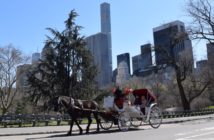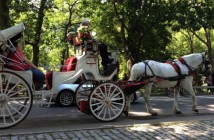WesternU Study: NYC Carriage Horses Less Stressed Than Those in Pastures
A study conducted by a team from Western University of Health Sciences in Pomona, California deemed New York City carriage horses are less stressed than those in pastures. The horses studied were quartered at Clinton Park Stables, West 52nd Street, New York from Aug. 3 to 5, 2014, to gauge what levels of stress the animals might have as a result of their work.
POMONA, CALIF. (PRWEB) APRIL 08, 2015
It doesn’t come straight from the horse’s mouth, but it could be the next best thing: A Western University of Health Sciences-led study indicates that while New York City Mayor Bill de Blasio is concerned about their welfare, carriage horses that trot the streets around Central Park and other NYC landmarks are not as stressed as the mayor might think.
Mayor de Blasio’s proposed ban on horse-dawn carriages has been a hotly debated topic in New York City since December 2014, when he proposed city legislation that would outlaw their operation. de Blasio, who was elected mayor in 2013 and took office in January 2014, is politically and financially backed by animal-rights advocates, and prior to taking office announced that he planned to “get rid of horse carriages, period,” in support of those who believe the horses are treated inhumanely.
His proposed code amendment, which requires a majority vote of the New York City Council, would go into effect June 1, 2016. The mayor has suggested replacing the carriages with electrically-powered antique cars.
Dr. Joseph Bertone, DVM, MS, DACVIM, WesternU College of Veterinary Medicine (CVM) Professor of Equine Medicine, approached the stable management with an idea to evaluate stress in the horses. Dr. Bertone, second-year CVM student Sarah Mercer-Bowyer, and CVM Assistant Professor of Physiology David Kersey, PhD studied the horses quartered at Clinton Park Stables, West 52nd Street, from Aug. 3 to 5, 2014, to gauge what levels of stress the animals might have as a result of their work.
Results of the study, “Evaluation of well-being of New York City carriage horses,” were presented February 27, 2015 at the International Federation of Applied Animal Behaviorists, Fort Worth, Texas. It has been accepted for presentation at the upcoming (June 4, 2015) Scientific Meeting of the American College of Veterinary Internal Medicine, Indianapolis, and Veterinary Behavior Symposium in Boston, and is submitted for presentation at the Annual Convention of the American Association of Equine Practitioners, Las Vegas, December 2015. It also is scheduled to be submitted to the Journal of the American Veterinary Medical Association.
“I wanted to identify the effect this situation has on these horses,” Bertone said, “Ultimately, I’m concerned about equine welfare. On the other hand, I’m also concerned over claims that could dismantle, or likely end, the lives of these grand horses. The same claims could see the loss of an iconic New York City institution, the loss of the important human-animal bond the drivers have with these spectacular animals, as well as have a profound negative economic impact on the people whose lives this would touch.
“So it’s important we collect the research and analyze the results objectively. In other words, let’s deal with the facts.”
Bertone and Mercer-Bowyer tested 13 of the more than 70 horses at Clinton Park. Five mares and eight geldings were selected at random.
The WesternU CVM group measured saliva cortisol from the animals at multiple time points in the workday. They also measured medial canthus temperature using a FLIR thermal imaging camera (IRT), and collected feces samples for fecal cortisol. Kersey and Mercer-Bowyer analyzed samples at Kersey’s lab at WesternU.
Four time points were used during testing:
- Time point 1: feces, saliva and IRT tests were collected an hour before horses went to work.
- Time point 2: saliva and IRT were collected after the horses were harnessed and as the horses walked were hitched to their carriages.
- Time point 3: saliva and IRT were collected as the horses returned from working.
- Time point 4: saliva and IRT were collected an hour after they worked, as they rested in their stalls.
“We found no evidence of stress in these horses. The conclusions made by the many experts in equine veterinary care who have visited the facility, and spent time in observation, is matched by the physiologic data we collected.” Bertone said. “Although not part of our study, we also observed for behavior associated with equine gastric ulcer syndrome. Ulcers result from stress. None of the behaviors were seen. We found the horses rested comfortably at night as well. That is another important feature of horses in a safe, comfortable environment.”
New York’s current regulations for working carriage horses can be found here. One regulation includes requiring the horses to get a five-week pasture furlough period per year.
Mercer-Bowyer was sent to a farm in Pennsylvania where horses go for “vacation,” to collect feces samples so that the WesternU CVM team could look at their levels of cortisol, which identifies stress. She took samples from the New York stable horses on vacation in pasture, with interesting results: Pasture horses have far greater range of fecal cortisol stress than their counterparts in New York City pulling carriages.
“The tendency is to anthropomorphize that they (pasture horses) are happier and better off,” Bertone said. “The truth is that (carriage horses) spend their lives in this stabled situation, with food in front of them and with their herd mates nearby. Horses are habitual herd animals. Being put out in a pasture for five weeks may not be that great of an experience for them.”
##
Western University of Health Sciences (http://www.westernu.edu), located in Pomona, Calif. and Lebanon, Ore., is an independent nonprofit health professions university, conferring degrees in biomedical sciences, dental medicine, health sciences, medical sciences, nursing, optometry, osteopathic medicine, pharmacy, physical therapy, physician assistant studies, podiatric medicine and veterinary medicine. WesternU is home to the Patient Care Center, where the best in collaborative health care services is offered. The Chronicle of Higher Education named WesternU a Great College to Work For in 2012, 2013 and 2014.
STUDY REVEALS NYC CARRIAGE HORSES DON’T APPEAR TO FIND WORK STRESSFUL
The presence of carriage horses in New York City continues to make headlines periodically, as city officials, animal welfare activists, and celebrities add their voices to the debate. The argument dates back to 2007, when the first bill to ban the carriages was introduced with the support of several politicians and animal welfare groups, who said the horses were overworked, placed in dangerous, stressful conditions, and not cared for in retirement. Pro-carriage supporters have countered that the horses are well-managed and have a number of city codes in place guiding their welfare.
In research presented at the 2015 American Association of Equine Practitioners Annual Convention, Dr. Sarah Mercer-Bowyer of California’s Western University of Health Sciences sought to learn more about how the horses process their urban environment, and whether their lifestyles do indeed cause them stress. Mercer-Bowyer and her research team used three parameters to measure stress at different times of the horses’ workdays—glucocorticoids from manure, cortisol from saliva, and thermography scans.
Glucocorticoids are steroid hormones made by the adrenal gland that guide the utilization of carbohydrates, fats, and proteins stored in the body. They are known to have anti-inflammatory effects and are released in response to stress, the idea being that an animal suddenly finding itself in danger needs to tap into its energy resources in order to escape. Cortisol is a type of glucocorticoid, and measuring both in manure and in saliva gave researchers a sense of the horse’s overall stress level, as well as its current, more acute state.
Thermography produces the rainbow-colored images often seen of the brain or body, showing areas of heat indicating activity. The researchers in this study used a non-invasive machine to measure the amount of activity around the horses’ eyes to look for changes that could be related to stress at different points in the day. The sympathetic nervous system, which manages the body’s fight or flight response, would cause an increase in the horse’s temperature if activated, easily measured on the animal’s face.
Mercer-Bowyer examined five horses vacationing on a farm outside the city and 13 working horses over three days, taking measurements at rest, as they were tacked up for work, returning from work, and one hour after leaving work. The researchers could find no difference between the working horses and those on vacation in terms of fecal stress measurements. There was a slight increase in salivary cortisol immediately after the horses returned to the barn after a day at work, but the levels remained the same throughout the rest of the day and were not considered unusually high at any point. The variation could have been explained by a natural change in metabolism as a result of their time on the clock. There were no unusual findings related to the horses’ temperatures during their workdays, either.
The data seems to indicate that carriage horses do not appear to ‘worry’ about their shifts, and don’t seem to come back from work on the city’s streets nervous and overwrought. Mercer-Bowyer added that the horses seemed outwardly relaxed and well-fed, having settled into a comfortable routine with their handlers.
“The results of our study indicate that the carriage horses’ lifestyle is not negatively impacting their well-being,” said Mercer-Bowyer. “When you look at these findings alongside the impeccable care these horses receive, it becomes clear that this is not an equine welfare issue.”




13 Comments
Pingback: Thank You
zu6vsx
w9klzf
m8d9p8
yg5hnh
40jq1w
jhn1lz
q03wxo
ioqyuo
gluww7
ploour
i26w9e
pnzz1a